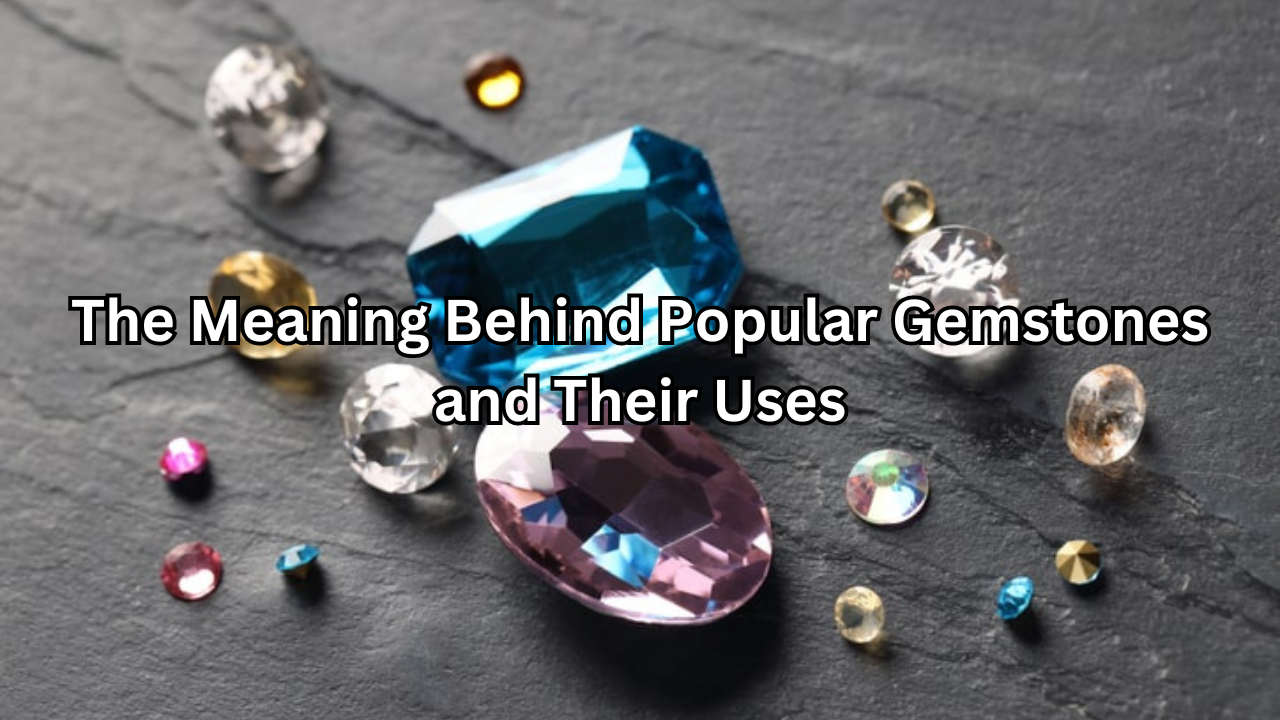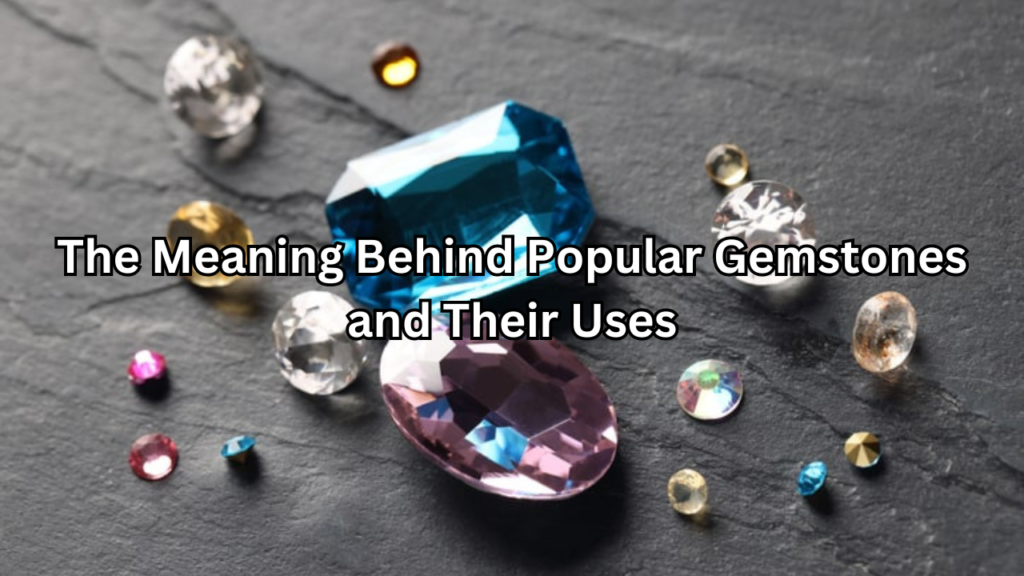

Table of Contents
Introduction
Gemstones have captivated human imagination for millennia, revered not only for their dazzling beauty but also for their deeper significance. Across cultures and ages, these precious stones have been imbued with meanings that extend beyond their physical allure, serving as symbols of power, healing, and spiritual enlightenment. From ancient civilizations to contemporary practices, gemstones have held a place of honor in both ceremonial and everyday contexts.
The purpose of this article is to delve into the fascinating world of gemstones, exploring the meanings attributed to some of the most popular stones and their various uses. By understanding the symbolic and practical roles these gemstones play, we can gain insight into their enduring appeal and how they continue to influence our lives. Whether you’re drawn to their aesthetic charm or their reputed metaphysical properties, this exploration will uncover the significance behind these timeless treasures.
Diamond
Meaning: Diamonds are renowned as symbols of eternal love, strength, and clarity. Their unparalleled hardness and brilliance have made them emblematic of enduring commitment and resilience. The clarity and purity of diamonds are often associated with truth and unwavering strength, making them a powerful symbol in both personal and symbolic contexts.
Uses: Diamonds are most famously used in engagement rings, where their enduring nature and brilliance symbolize the lasting commitment of marriage. Beyond romantic jewelry, diamonds are also featured in various other types of fine fashion jewelry, including necklaces, earrings, and bracelets. Their exceptional hardness makes them invaluable in industrial applications as well, where they are used for cutting, grinding, and drilling in various manufacturing processes.
Historical and Cultural Significance: Throughout history, diamonds have held a prestigious place in cultures around the world. In ancient India, diamonds were considered to bring protection and strength, often set in the armor of warriors. In Western cultures, diamonds gained prominence in the 20th century as the quintessential symbol of engagement, thanks in large part to marketing campaigns such as De Beers’ iconic slogan, “A Diamond is Forever.” Their role in shaping societal norms and their association with high status have cemented diamonds’ place as one of the most revered and sought-after gemstones in history.
Ruby
Meaning: Rubies are celebrated for their vibrant red color and are often associated with passion, vitality, and protection. The intense hue of rubies is believed to stimulate the heart chakra, enhancing emotions of love and enthusiasm. They are also considered to provide strength and courage, shielding the wearer from negative energies and ensuring emotional and physical well-being.
Uses: Rubies are a popular choice in fine jewelry, particularly in engagement rings, where their fiery color symbolizes enduring love and commitment. They are also used in various royal ornaments and heirloom pieces due to their stunning appearance and durability. The rich red of rubies makes them a favored gemstone for creating bold and luxurious designs in rings, necklaces, and bracelets.
Historical and Cultural Significance: Historically, rubies have been treasured by royalty and nobility across various cultures. In ancient Burma (now Myanmar), rubies were believed to make the wearer invincible in battle and were often embedded in the armor of warriors. In European history, rubies were considered a symbol of power and protection, frequently used in crowns and ceremonial regalia. The gemstone’s association with passion and vitality has maintained its esteemed status throughout history.
Sapphire
Meaning: Sapphires are traditionally symbols of wisdom, nobility, and purity. Their deep blue color is often associated with the sky and the heavens, embodying qualities of wisdom and divine favor. Sapphires are believed to provide mental clarity and promote serenity, making them a favored gemstone for those seeking insight and enlightenment.
Uses: Sapphires are prominently used in fine jewelry, especially in engagement rings where their deep blue hue represents a commitment to loyalty and fidelity. They are also featured in royal regalia and ceremonial pieces due to their regal appearance and durability. Sapphires come in various colors, but the blue sapphire remains the most iconic and sought after.
Historical and Cultural Significance: Throughout history, sapphires have been revered by various cultures. In medieval Europe, they were believed to protect against envy and harm and were often set in clergy’s rings as symbols of wisdom and purity. The famous “Engagement Ring of Princess Diana,” which features a large blue sapphire, further cemented its association with royalty and elegance. The gemstone’s enduring legacy in royal traditions and its place in various cultural artifacts underscore its timeless significance.
Emerald
Meaning: Emeralds are renowned for their vibrant green color and are associated with rebirth, love, and fertility. The rich green hue of emeralds symbolizes renewal and growth, making them a powerful emblem of fresh starts and personal development. They are also believed to enhance love and compassion, as well as to bring harmony and balance to relationships.
Uses: Emeralds are often used in high-end jewelry, where their striking green color adds a touch of luxury and elegance. They are particularly favored in decorative items and fine jewelry such as rings, necklaces, and earrings. Emeralds are also used in historical and ceremonial pieces, reflecting their long-standing association with opulence and refinement.
Historical and Cultural Significance: Throughout history, emeralds have been treasured by various cultures for their beauty and symbolism. In ancient Egypt, emeralds were associated with the goddess Isis and were believed to have protective and healing properties. Cleopatra, known for her love of emeralds, adorned herself with them and even used them in her jewelry. In the medieval period, emeralds were considered symbols of fertility and were often worn by royalty and clergy. Their rich history and cultural significance continue to enhance their allure and status as a gemstone of great prestige.
Amethyst
Meaning: Amethyst is widely regarded as a symbol of peace, tranquility, and clarity of mind. Its soothing violet hues are believed to promote emotional balance and mental clarity, helping to alleviate stress and anxiety. Amethyst is also thought to enhance spiritual awareness and support a tranquil state of mind.
Uses: In jewelry, amethyst is commonly featured in rings, necklaces, and earrings. Its calming color makes it a popular choice for pieces intended to provide a sense of relaxation and peace. Beyond adornment, amethyst is also utilized in spiritual practices, such as meditation and healing rituals, where it is believed to help clear the mind and foster a sense of inner calm.
Historical and Cultural Significance: Amethyst has a long history of use in various cultures. In ancient Greece, it was believed that wearing amethyst could prevent intoxication and ensure sober thoughts, a belief reflected in its name, derived from the Greek word “amethystos,” meaning “not drunk.” Throughout history, it has been associated with nobility and was often used in royal regalia and clergy’s attire. Its rich historical associations with clarity and sobriety have continued to enhance its popularity across cultures and eras.
Topaz
Meaning: Topaz is associated with strength, intellect, and protection. The gemstone is believed to enhance mental clarity and foster intellectual growth, while also offering protection against negative energies. Its warm, golden hues are thought to inspire confidence and resilience in the wearer.
Uses: Topaz is used in a variety of jewelry pieces, ranging from classic to contemporary designs. Available in multiple colors, including blue, pink, and yellow, it can be cut into various shapes to suit different styles. Its versatility and wide range of hues make it a popular choice for both everyday wear and statement pieces.
Historical and Cultural Significance: Historically, topaz was valued by ancient civilizations for its reputed protective qualities. In ancient Egypt, it was believed to possess the power to ward off evil and ensure the wearer’s safety. Topaz has also been associated with royalty and was used in crowns and scepters throughout history. Its enduring appeal across different cultures underscores its significance as a gemstone of strength and wisdom.
Garnet
Meaning: Garnet is known for symbolizing vitality, strength, and protection. The gemstone’s deep, rich colors are thought to invigorate the spirit and provide a sense of personal power and resilience. Garnet is also believed to offer protection and stability, making it a popular choice for those seeking courage and strength.
Uses: Garnet is frequently used in both antique and modern jewelry designs. Its vibrant hues, which range from deep red to green, make it a versatile gemstone for creating striking rings, necklaces, and earrings. The gemstone’s historical associations with vitality and protection also contribute to its popularity in engagement rings and heirloom pieces.
Historical and Cultural Significance: Garnets have been cherished by various cultures throughout history. In ancient Rome, garnets were worn as talismans believed to protect against injury and improve overall well-being. During the medieval period, garnets were often used in ceremonial and ecclesiastical jewelry, reflecting their association with power and protection. The gemstone’s long-standing significance and its role in both historical and modern designs continue to highlight its enduring appeal.
Opal
Meaning: Opal is celebrated for representing creativity, inspiration, and emotional healing. Its unique play-of-color is believed to stimulate creativity and inspire new ideas, while also providing emotional healing and insight. The gemstone’s shifting hues are thought to mirror the emotional spectrum, fostering a deeper understanding of oneself.
Uses: Opal is particularly favored in unique and artistic jewelry pieces due to its mesmerizing and ever-changing colors. It is used in a variety of designs, from delicate rings and necklaces to bold statement pieces. The gemstone’s ability to reflect light in multiple colors makes it a favorite among designers seeking to create distinctive and imaginative jewelry.
Historical and Cultural Significance: Opal has a rich history and has been valued by various cultures for its captivating appearance. In ancient Rome, opals were considered symbols of hope and purity. During the Renaissance, opal was believed to possess protective qualities and was often worn by royalty and nobility. The gemstone’s historical association with inspiration and creativity has continued into modern times, reinforcing its status as a gem of artistic and emotional significance.
Conclusion
In our exploration of gemstones, we have delved into the rich tapestry of meanings and uses that define these captivating treasures. From the passionate red of rubies to the serene violet of amethysts, each gemstone carries its own unique significance and historical background, reflecting a wide range of human experiences and cultural values.
Recap of the Meanings and Uses of the Gemstones Discussed
Women, with their unrivaled brilliance and hardness, symbolize eternal love, strength, and clarity, making them a timeless choice for engagement rings and high-end jewelry, as well as for industrial applications. Rubies, known for their vibrant red color, represent passion, vitality, and protection, and are often featured in both antique and contemporary jewelry designs. Sapphires, embodying wisdom, nobility, and purity, are prized for their deep blue hue and are used in engagement rings and royal regalia. Emeralds, with their rich green tones, symbolize rebirth, love, and fertility, finding their place in luxurious jewelry and decorative items.
Amethysts are celebrated for their calming properties, symbolizing peace and mental clarity, and are used in both spiritual practices and fine jewelry. Topaz, associated with strength, intellect, and protection, is versatile in its application, appearing in various cuts and colors in jewelry. Garnets, known for their vitality and protective qualities, are cherished in both antique and modern designs. Finally, opals, with their unique play-of-color, represent creativity, inspiration, and emotional healing, making them ideal for artistic and distinctive jewelry pieces.
Final Thoughts on the Significance of Gemstones in Personal and Cultural Contexts
Gemstones have transcended time and culture, serving not only as symbols of personal values and aspirations but also as reflections of cultural heritage and societal status. Their meanings and uses are deeply intertwined with human history, offering insight into the beliefs and practices of different civilizations. Whether used in ceremonial regalia, engagement rings, or spiritual rituals, gemstones continue to hold significant personal and cultural value.
Encouragement to Explore Gemstones and Their Meanings Further
As we conclude our journey through the world of gemstones, we encourage you to delve deeper into the meanings and uses of these fascinating stones. Explore how different gemstones, when paired with the right equipment, resonate with your own values and experiences, and consider how they can enhance your personal and spiritual life. Whether you are drawn to their beauty, symbolic meanings, or historical significance, using proper equipment can help you unlock the full potential of gemstones. By understanding and appreciating these treasures, and utilizing the necessary tools, you can connect more deeply with their significance and incorporate their unique properties into your own life and practices.





